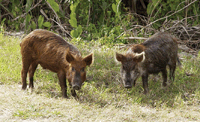New Institute Promotes Innovative Collaborations in the Mathematical and Life Sciences
October 18, 2009

Feral swine, an invasive species in Great Smoky Mountains National Park, are susceptible to diseases like pseudo-rabies. A working group at the National Institute for Mathematical and Biological Synthesis at the University of Tennessee, Knoxville, was created to manage outbreaks of this and other diseases afflicting wild animals in natural areas.
Novel mathematical modeling approaches for the solution of basic and applied problems in the life sciences are the focus of activities at the new National Institute for Mathematical and Biological Synthesis at the University of Tennessee, Knoxville. Since it opened its doors in March, more than 400 scientists have participated in research and educational opportunities at the institute, which is known as NIMBioS (pronounced "nimbus").
Among the topics investigated to date is eradication of bovine tuberculosis, with models that allow the assessment of strategies like movement of cattle. Other projects include evaluation of methods for improved management of emerging infectious diseases, and new models developed as part of efforts to control pseudo-rabies in feral swine.
NIMBioS arose from a collaborative effort of the National Science Foundation and two other agency sponsors, the U.S. Department of Agriculture and the U.S. Department of Homeland Security. Its primary goals are to address key biological questions using cross-disciplinary approaches of mathematical biology and to foster the development of a cadre of researchers capable of conceiving and engaging in creative and collaborative connections across disciplines.
"To date, advances in the field of mathematical biology have been made by a handful of individuals and programs that have trained the vast majority of active researchers at this interface," says Louis Gross, NIMBioS director and UT professor of ecology and evolutionary biology and mathematics. "NIMBioS intends to foster the next step: continuing the development of individual researchers and also fostering the development of entire programs equipped to educate the mathematically competent and biologically knowledgeable researchers needed to address this century's challenging biological questions."
To reach its goals, NIMBioS has programs at four levels: (1) working groups, made up of 10�15 invited participants who focus on specific questions, meeting two or three times over a two-year period; (2) investigative workshops, in which 30�40 participants (half of whom are invited) focus on more open-ended general problems; (3) skill- and methods-based programs, called Tutorials, designed to broaden understanding of applications of modern mathematical and computational science in biology; and (4) education linked to re-search opportunities for participants from the elementary school level through the postdoctoral level. NIMBioS also offers support for short-term visits, longer visits by researchers on sabbatical, and postdoctoral fellowships.
Unlike most mathematical institutes, NIMBioS does not base its activities on an annual theme. Rather, research directions and activities are derived from requests for support from the research community and from collaborative efforts with industry and government agency partners. Requests are vetted by the NIMBioS leadership team, which consists of a director, deputy director, and four associate-level directors, as well as a 23-member international Board of Advisors and Committee to Promote Diversity. Industrial partners of NIMBioS include IBM and ESRI Inc.
An example of a collaborative effort with the federal government is the NIMBioS Working Group on Feral Swine and Pseudo-Rabies in Great Smoky Mountains National Park. Feral swine are an invasive species in the park; the population is growing so rapidly and becoming so large that about 575 hogs have been harvested so far in 2009. Both the burgeoning population and the diseases that can afflict the hogs, such as pseudo-rabies, are problems that need further investigation. With a goal of managing outbreaks of disease among wild animals in the Smokies and other natural areas, mathematical and biological researchers at several academic institutions joined wildlife managers at the park to initiate the working group.
NIMBioS accepts requests twice a year, in September and in March, for new working groups and new investigative workshops. Up to 20 working groups are expected to be formed each year. Other science institutes that have successfully advanced research through the use of working groups are the National Center for Ecological Analysis and Synthesis in Santa Barbara, California, and the National Evolutionary Synthesis Center in Durham, North Carolina.
Further information about research and educational opportunities at NIMBioS can be found at http://www.nimbios.org.
---Suzanne Lenhart, NIMBioS Associate Director for Education, Outreach, and Diversity.

